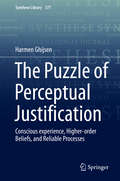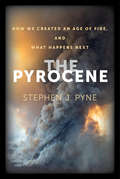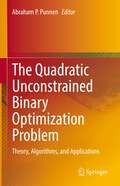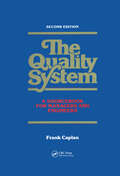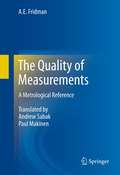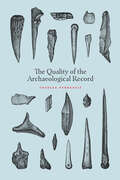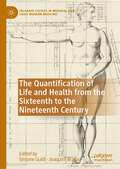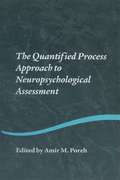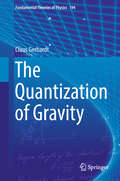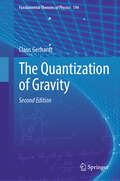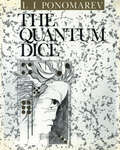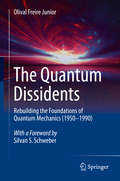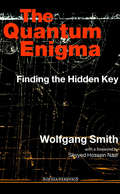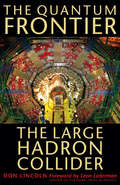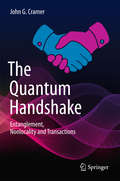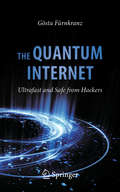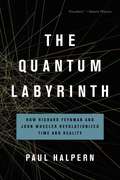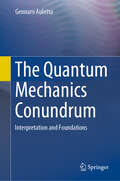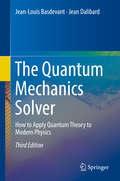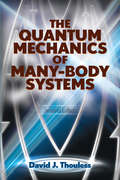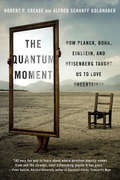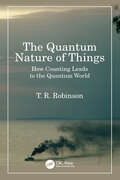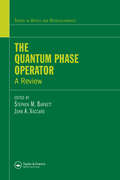- Table View
- List View
The Puzzle of Perceptual Justification: Conscious experience, Higher-order Beliefs, and Reliable Processes (Synthese Library #377)
by Harmen GhijsenThis book provides an accessible and up-to-date discussion of contemporary theories of perceptual justification that each highlight different factors related to perception, i.e., conscious experience, higher-order beliefs, and reliable processes. The book’s discussion starts from the viewpoint that perception is not only one of our fundamental sources of knowledge and justification, but also plays this role for many less sophisticated animals. It proposes a scientifically informed reliabilist theory which can accommodate this fact without denying that some of our epistemic abilities as human perceivers are special. This allows it to combine many of our intuitions about the importance of conscious experience and higher-order belief with the controversial thesis that perceptual justification is fundamentally non-evidential in character.
The Pyrocene: How We Created an Age of Fire, and What Happens Next
by Stephen J. PyneA dramatic reorientation of humanity’s relationship with fireThe Pyrocene tells the story of what happened when a fire-wielding species, humanity, met an especially fire-receptive time in Earth's history. Since terrestrial life first appeared, flames have flourished. Over the past two million years, however, one genus gained the ability to manipulate fire, swiftly remaking both itself and eventually the world. We developed small guts and big heads by cooking food; we climbed the food chain by cooking landscapes; and now we have become a geologic force by cooking the planet. Some fire uses have been direct: fire applied to convert living landscapes into hunting grounds, forage fields, farms, and pastures. Others have been indirect, through pyrotechnologies that expanded humanity's reach beyond flame's grasp. Still, preindustrial and Indigenous societies largely operated within broad ecological constraints that determined how, and when, living landscapes could be burned. These ancient relationships between humans and fire broke down when people began to burn fossil biomass—lithic landscapes—and humanity’s firepower became unbounded. Fire-catalyzed climate change globalized the impacts into a new geologic epoch. The Pleistocene yielded to the Pyrocene. Around fires, across millennia, we have told stories that explained the world and negotiated our place within it. The Pyrocene continues that tradition, describing how we have remade the Earth and how we might recover our responsibilities as keepers of the planetary flame.
The Quadratic Unconstrained Binary Optimization Problem: Theory, Algorithms, and Applications
by Abraham P. PunnenThe quadratic binary optimization problem (QUBO) is a versatile combinatorial optimization model with a variety of applications and rich theoretical properties. Application areas of the model include finance, cluster analysis, traffic management, machine scheduling, VLSI physical design, physics, quantum computing, engineering, and medicine. In addition, various mathematical optimization models can be reformulated as a QUBO, including the resource constrained assignment problem, set partitioning problem, maximum cut problem, quadratic assignment problem, the bipartite unconstrained binary optimization problem, among others.This book presents a systematic development of theory, algorithms, and applications of QUBO. It offers a comprehensive treatment of QUBO from various viewpoints, including a historical introduction along with an in-depth discussion of applications modelling, complexity and polynomially solvable special cases, exact and heuristic algorithms, analysis of approximation algorithms, metaheuristics, polyhedral structure, probabilistic analysis, persistencies, and related topics. Available software for solving QUBO is also introduced, including public domain, commercial, as well as quantum computing based codes.
The Quality System: A Sourcebook for Managers and Engineers, Second Edition
by Frank CaplanIn its second edition, the purpose of this handbook is to assist remediation site managers and their operating contractors in ensuring that each remediation system is effectively making progress toward site cleanup objectives and remains protective of human health and the environment.
The Quality of Measurements
by Paul Makinen A. E. Fridman Andrew SabakThis monograph and translation from the Russian describes in detail and comments on the fundamentals of metrology. The basic concepts of metrology, the principles of the International System of Units SI, the theory of measurement uncertainty, the new methodology of estimation of measurement accuracy on the basis of the uncertainty concept, as well as the methods for processing measurement results and estimating their uncertainty are discussed from the modern position. It is shown that the uncertainty concept is compatible with the classical theory of accuracy. The theory of random uncertainties is supplemented with their most general description on the basis of generalized normal distribution; the instrumental systematic errors are presented in connection with the methodology of normalization of the metrological characteristics of measuring instruments. The information about modern systems of traceability is given. All discussed theoretical principles and calculation methods are illustrated with examples.
The Quality of the Archaeological Record
by Charles PerreaultPaleobiology struggled for decades to influence our understanding of evolution and the history of life because it was stymied by a focus on microevolution and an incredibly patchy fossil record. But in the 1970s, the field took a radical turn, as paleobiologists began to investigate processes that could only be recognized in the fossil record across larger scales of time and space. That turn led to a new wave of macroevolutionary investigations, novel insights into the evolution of species, and a growing prominence for the field among the biological sciences. In The Quality of the Archaeological Record, Charles Perreault shows that archaeology not only faces a parallel problem, but may also find a model in the rise of paleobiology for a shift in the science and theory of the field. To get there, he proposes a more macroscale approach to making sense of the archaeological record, an approach that reveals patterns and processes not visible within the span of a human lifetime, but rather across an observation window thousands of years long and thousands of kilometers wide. Just as with the fossil record, the archaeological record has the scope necessary to detect macroscale cultural phenomena because it can provide samples that are large enough to cancel out the noise generated by micro-scale events. By recalibrating their research to the quality of the archaeological record and developing a true macroarchaeology program, Perreault argues, archaeologists can finally unleash the full contributive value of their discipline.
The Quantification of Life and Health from the Sixteenth to the Nineteenth Century: Intersections of Medicine and Philosophy (Palgrave Studies in Medieval and Early Modern Medicine)
by Joaquim Braga Simone GuidiThis edited volume explores the intersection of medicine and philosophy throughout history, calling attention to the role of quantification in understanding the medical body. Retracing current trends and debates to examine the quantification of the body throughout the early modern, modern and early contemporary age, the authors contextualise important issues of both medical and philosophical significance, with chapters focusing on the quantification of temperaments and fluids, complexions, functions of the living body, embryology, and the impact of quantified reasoning on the concepts of health and illness. With insights spanning from the sixteenth century to the nineteenth century, this book provides a wide-ranging overview of attempts to ‘quantify’ the human body at various points. Arguing that medicine and philosophy have been constantly in dialogue with each other, the authors discuss how this provided a strategic opportunity both for medical thought and philosophy to refine and further develop. Given today’s fascination with the quantification of the body, represented by the growing profusion of self-tracking devices logging one’s sleep, diet or mood, this collection offers an important and timely contribution to an emerging and interdisciplinary field of study.
The Quantified Process Approach to Neuropsychological Assessment (Studies on Neuropsychology, Neurology and Cognition)
by Amir M. PorehSince the late 1800s psychologists have been interested in discerning the strategies subjects employ to solve psychological tests (Piaget, 1928, Werner, 1940, Gesell, 1941). Much of this work, however, has relied on qualitative observations. In the 1970s, Edith Kaplan adopted this approach to the analysis of standardized neuropsychological measures. Unlike her predecessors, Dr. Kaplan and her colleagues emphasized the application of modern behavioral neurology to the analysis of the test data. Her approach was later termed the Boston Process Approach to neuropsychological assessment. While Edith Kaplan's work generates a great deal of enthusiasm, the qualitative nature of her analyses did not allow for its adoption by mainstream neuropsychologists. However, in recent years this limitation has begun to be addressed. Clinicians and researchers have developed new methodologies for quantifying the Boston Process Approach, leading to the emergence of a new field, which is collectively termed the Quantified Process Approach. Quantified Process Approach to Neuropsychological Assessment outlines the rationale for the emergence of this new approach and reviews the state of the art research literature and up to date clinical applications as they pertain to the evaluation of neuropsychiatric, head injured, and learning disabled patients. When available, norms and scoring forms are included in the appendices.
The Quantization of Gravity (Fundamental Theories of Physics #194)
by Claus GerhardtA unified quantum theory incorporating the four fundamental forces of nature is one of the major open problems in physics. The Standard Model combines electro-magnetism, the strong force and the weak force, but ignores gravity. The quantization of gravity is therefore a necessary first step to achieve a unified quantum theory. In this monograph a canonical quantization of gravity has been achieved by quantizing a geometric evolution equation resulting in a gravitational wave equation in a globally hyperbolic spacetime. Applying the technique of separation of variables we obtain eigenvalue problems for temporal and spatial self-adjoint operators where the temporal operator has a pure point spectrum with eigenvalues $\lambda_i$ and related eigenfunctions, while, for the spatial operator, it is possible to find corresponding eigendistributions for each of the eigenvalues $\lambda_i$, if the Cauchy hypersurface is asymptotically Euclidean or if the quantized spacetime is a black hole with a negative cosmological constant. The hyperbolic equation then has a sequence of smooth solutions which are products of temporal eigenfunctions and spatial eigendistributions. Due to this "spectral resolution" of the wave equation quantum statistics can also be applied to the quantized systems. These quantum statistical results could help to explain the nature of dark matter and dark energy.
The Quantization of Gravity (Fundamental Theories of Physics #194)
by Claus GerhardtA unified quantum theory incorporating the four fundamental forces of nature is one of the major open problems in physics. The Standard Model combines electro-magnetism, the strong force and the weak force, but ignores gravity. The quantization of gravity is therefore a necessary first step to achieve a unified quantum theory. In this monograph a canonical quantization of gravity has been achieved by quantizing a geometric evolution equation resulting in a hyperbolic equation in a fiber bundle, where the base space represents a Cauchy hypersurface of the quantized spacetime and the fibers the Riemannian metrics in the base space. The hyperbolic operator, a second order partial differential operator, acts both in the fibers as well as in the base space. In this second edition new results are presented which allow the solutions of the hyperbolic equation to be expressed as products of spatial and temporal eigenfunctions of self-adjoint operators. These eigenfunctions form complete bases in appropriate Hilbert spaces. The eigenfunctions depending on the fiber elements are a subset of the Fourier kernel of the symmetric space SL(n,R)/SO(n), where n is the dimension of the base space; they represent the elementary gravitons corresponding to the degrees of freedom in choosing the entries of Riemannian metrics with determinants equal to one. These are all the degrees of freedom available because of the coordinate system invariance: For any smooth Riemannian metric there exists an atlas such that in each chart the determinant of the metric is equal to one. In the important case n=3 the Standard Model could also be incorporated such that one can speak of a unified quantization of all four fundamental forces of nature.
The Quantum Dice
by L.I Ponomarev I.V Kurchatov"Real black magic calculus" is how Albert Einstein described quantum mechanics in a letter in 1925. Quantum mechanics is now rather more widely understood by physicists, but still many "outsiders" are unaware of what quantum mechanics is, how it has changed the course of development of physics and how it affects their everyday lives. This book gives a fascinating account of the evolution of the ideas and concepts of quantum theory and modern physics, written by an "insider" but aimed specifically at the general science reader. Many anecdotes from famous past physicists give an insight into their work and personalities. The many illustrations are an important and attractive feature of the book. Leonid Ponomarev is a leading theoretical physicist. His deep understanding of the subject is allied with his wide knowledge of history, literature and philosophy to produce this history of the development of modern physics and its impact on our lives.
The Quantum Dissidents
by Olival Freire JuniorThis book tells the fascinating story of the people and events behind the turbulent changes in attitudes to quantum theory in the second half of the 20th century. The huge success of quantum mechanics as a predictive theory has been accompanied, from the very beginning, by doubts and controversy about its foundations and interpretation. This book looks in detail at how research on foundations evolved after WWII, when it was revived, until the mid 1990s, when most of this research merged into the technological promise of quantum information. It is the story of the quantum dissidents, the scientists who brought this subject from the margins of physics into its mainstream. It is also a history of concepts, experiments, and techniques, and of the relationships between physics and the world at large, touching on themes such as the Cold War, McCarthyism, Zhdanovism, and the unrest of the late 1960s.
The Quantum Enigma: Finding the Hidden Key
by Wolfgang SmithFollowing the overthrow of the classical world picture by the findings of quantum mechanics, physicists have proposed a broad gamut of alternative world views. This book begins with the major recognition that each of these suffers from a certain 'residual Cartesianism' that has been smuggled in unconsciously. It turns out that the moment one discards this hidden and problematic premise, quantum theory begins to 'make sense' in a way that it never has before. As the author shows, it is now possible, for the first time, to integrate the findings of quantum physics into a world view that is neither forced nor ad hoc, but conforms to the permanent intuitions of mankind. Surprisingly, this treatise can be read not only by scientists, but also by readers unacquainted with the technical conceptions of physics or the quantum-reality literature.
The Quantum Frontier: The Large Hadron Collider
by Don LincolnThe highest-energy particle accelerator ever built, the Large Hadron Collider runs under the border between France and Switzerland. It leapt into action on September 10, 2008, amid unprecedented global press coverage and widespread fears that its energy would create tiny black holes that could destroy the earth. By smashing together particles smaller than atoms, the LHC recreates the conditions hypothesized to have existed just moments after the big bang. Physicists expect it to aid our understanding of how the universe came into being and to show us much about the standard model of particle physics—even possibly proving the existence of the mysterious Higgs boson. In exploring what the collider does and what it might find, Don Lincoln explains what the LHC is likely to teach us about particle physics, including uncovering the nature of dark matter, finding micro black holes and supersymmetric particles, identifying extra dimensions, and revealing the origin of mass in the universe.Thousands of physicists from around the globe will have access to the LHC, none of whom really knows what outcomes will be produced by the $7.7 billion project. Whatever it reveals, the results arising from the Large Hadron Collider will profoundly alter our understanding of the cosmos and the atom and stimulate amateur and professional scientists for years to come.
The Quantum Handshake
by John G. CramerThis book shines bright light into the dim recesses of quantum theory, where the mysteries of entanglement, nonlocality, and wave collapse have motivated some to conjure up multiple universes, and others to adopt a "shut up and calculate" mentality. After an extensive and accessible introduction to quantum mechanics and its history, the author turns attention to his transactional model. Using a quantum handshake between normal and time-reversed waves, this model provides a clear visual picture explaining the baffling experimental results that flow daily from the quantum physics laboratories of the world. To demonstrate its powerful simplicity, the transactional model is applied to a collection of counter-intuitive experiments and conceptual problems.
The Quantum Internet: Ultrafast and Safe from Hackers
by Gösta FürnkranzThe internet can look forward to a fantastic future! With new quantum technology, hacker-proof exchange of information and ultrafast data processing will become possible. The basis for these is Albert Einstein's "quantum spook". We are not dealing here with sorcery, but with hard-core science. This book undertakes a fascinating journey through the world of our quantum future - from the first "quantum satellite" to high-security internet, the quantum cloud and beyond, to partly futuristic applications. The author guides the reader through the basic ideas of quantum physics, explains the concepts of quantum computers, quantum cryptography, and quantum teleportation, and then establishes their relationship to the quantum Internet. Special attention is paid not only to the technical challenges involved, but also to the likely effects on society. Alongside examples of implementation, the author intersperses delightful anecdotes, which bring the story to life. With this book you will learn how quantum physics can revolutionize the internet! "... in lively prose the author presents the current state of research in its whole breadth and splendour – valuable and entertaining reading!” Rupert Ursin, Group Leader and Vice Director of the Institute for Quantum Optics and Quantum Information, Vienna
The Quantum Labyrinth: How Richard Feynman and John Wheeler Revolutionized Time and Reality
by Paul HalpernThe story of the unlikely friendship between the two physicists who fundamentally recast the notion of time and historyIn 1939, Richard Feynman, a brilliant graduate of MIT, arrived in John Wheeler's Princeton office to report for duty as his teaching assistant. A lifelong friendship and enormously productive collaboration was born, despite sharp differences in personality. The soft-spoken Wheeler, though conservative in appearance, was a raging nonconformist full of wild ideas about the universe. The boisterous Feynman was a cautious physicist who believed only what could be tested. Yet they were complementary spirits. Their collaboration led to a complete rethinking of the nature of time and reality. It enabled Feynman to show how quantum reality is a combination of alternative, contradictory possibilities, and inspired Wheeler to develop his landmark concept of wormholes, portals to the future and past. Together, Feynman and Wheeler made sure that quantum physics would never be the same again.
The Quantum Mechanics Conundrum: Interpretation and Foundations
by Gennaro AulettaThis comprehensive volume gives a balanced and systematic treatment of both the interpretation and the mathematical-conceptual foundations of quantum mechanics. It is written in a pedagogical style and addresses many thorny problems of fundamental physics.The first aspect concerns Interpretation. The author raises the central problems: formalism, measurement, non-locality, and causality. The main positions on these subjects are presented and critically analysed. The aim is to show that the main schools can converge on a core interpretation. The second aspect concerns Foundations. Here it is shown that the whole theory can be grounded on information theory. The distinction between information and signal leads us to integrating quantum mechanics and relativity. Category theory is presented and its significance for quantum information shown; the logic and epistemological bases of the theory are assessed.Of relevance to all physicists and philosophers with an interest in quantum theory and its foundations, this book is destined to become a classic work.
The Quantum Mechanics Solver: How to Apply Quantum Theory to Modern Physics (Advanced Texts In Physics Ser.)
by Jean-Louis Basdevant Jean DalibardMotivates students by challenging them with real-life applications of the somtimes esoteric aspects of quantum mechanics that they are learning. Offers completely original excerices developed at teh Ecole Polytechnique in France, which is know for its innovative and original teaching methods. Problems from modern physics to help the student apply just-learnt theory to fields such as molecular physics, condensed matter physics or laser physics.
The Quantum Mechanics of Many-Body Systems: Second Edition (Dover Books on Physics)
by D. J. ThoulessThis monograph introduces advanced undergraduates and graduate students of physics to the "many-body" theory in theoretical physics. The treatment addresses problems and solutions related to nuclear and atomic physics, the electron theory of metals, and the theories of liquid helium three and four. A unified account of the field rather than a description of parallel methods, the text's main thematic approaches include the self-consistent field and its generalizations, perturbation theory and the use of Feynman diagrams, and the use of Green functions to describe excitations of a many-body system. The primary emphasis is on the theories of atomic nuclei, the electron gas, superconductivity, and liquid helium three. A familiarity with the principles of nonrelativistic quantum mechanics and statistical mechanics is assumed, but a detailed knowledge of nuclear and solid state physics is unnecessary.
The Quantum Moment: How Planck, Bohr, Einstein, and Heisenberg Taught Us to Love Uncertainty
by Robert P. Crease Alfred Scharff GoldhaberThe fascinating story of how quantum mechanics went mainstream. The discovery of the quantum--the idea, born in the early 1900s in a remote corner of physics, that energy comes in finite packets instead of infinitely divisible quantities--planted a rich set of metaphors in the popular imagination. Quantum imagery and language now bombard us like an endless stream of photons. Phrases such as multiverses, quantum leaps, alternate universes, the uncertainty principle, and Schrödinger's cat get reinvented continually in cartoons and movies, coffee mugs and T-shirts, and fiction and philosophy, reinterpreted by each new generation of artists and writers. Is a "quantum leap" big or small? How uncertain is the uncertainty principle? Is this barrage of quantum vocabulary pretentious and wacky, or a fundamental shift in the way we think? All the above, say Robert P. Crease and Alfred Scharff Goldhaber in this pathbreaking book. The authors--one a philosopher, the other a physicist--draw on their training and six years of co-teaching to dramatize the quantum's rocky path from scientific theory to public understanding. Together, they and their students explored missteps and mistranslations, jokes and gibberish, of public discussion about the quantum. Their book explores the quantum's manifestations in everything from art and sculpture to the prose of John Updike and David Foster Wallace. The authors reveal the quantum's implications for knowledge, metaphor, intellectual exchange, and the contemporary world. Understanding and appreciating quantum language and imagery, and recognizing its misuse, is part of what it means to be an educated person today. The result is a celebration of language at the interface of physics and culture, perfect for anyone drawn to the infinite variety of ideas.
The Quantum Nature of Things: How Counting Leads to the Quantum World
by T R RobinsonThis book offers readers an entirely original and unconventional view of quantum mechanics. It is a view that accepts quantum mechanics as the natural way to think about the way nature works, rather than the view commonly expressed, especially in books on quantum physics, that quantum theory is weird and counterintuitive. It is based on the concept of itemization. From this simple premise, quantities like energy and momentum, both linear and angular emerge naturally, as do configuration space, potentials, the electromagnetic field, many-body dynamics, special relativity and relativistic wave mechanics. The many-body dynamics, because it is not tied to physics from the outset, can be applied to population dynamics outside physics as well as the usual physical situations. From this emerges much of the basic physics that describes, mathematically, how the natural world behaves. This accessible introduction does not require exotic maths, and is aimed at inquisitive physics students and professionals who are interested in exploring unconventional approaches to physics. It may also be of interest to anyone studying quantum information theory or quantum computing. Key Features Provides a unique, new approach to understanding quantum mechanics. Uses basic concepts and mathematical methods accessible at the undergraduate level. Presents applications outside physics, including a newly devised and original model of cell division that shows how cancer-cell population explosions occur.
The Quantum Phase Operator: A Review
by Stephen M. Barnett John A. VaccaroDescribing the phase of an electromagnetic field mode or harmonic oscillator has been an obstacle since the early days of modern quantum theory. The quantum phase operator was even more problematic with the invention of the maser and laser in the 1950s and 1960s. This problem was not solved until the Pegg-Barnett formalism was developed in the 1980
The Quantum Physics of Atomic Frequency Standards: Recent Developments
by Jacques Vanier Cipriana TomescuUp-to-Date Coverage of Stable and Accurate Frequency StandardsThe Quantum Physics of Atomic Frequency Standards: Recent Developments covers advances in atomic frequency standards (atomic clocks) from the last several decades. It explains the use of various techniques, such as laser optical pumping, coherent population trapping, laser cooling, and e
The Quantum Physics of Atomic Frequency Standards: Recent Developments
by Jacques Vanier Cipriana TomescuThe Quantum Physics of Atomic Frequency Standards: Recent Developments, Second Edition, covers advances in atomic frequency standards (atomic clocks) from the last several decades. It explains the use of various techniques, such as laser optical pumping, coherent population trapping, laser cooling, and electromagnetic and optical trapping, in the implementation of classical microwave and optical atomic frequency standards.It provides an up-to-date, in-depth view of the vast improvements to atomic clocks that have occurred in the last 25 years. The improved stability and accuracy enable the verification of physical concepts used in fundamental theories, such as relativity, as well as the stability of fundamental constants intrinsic to those theories.The book first discusses improvements to conventional atomic frequency standards, highlighting the main limitations of those frequency standards and the physical basis of the limitations. It then describes how advances in the theory and applications of atomic physics have opened new avenues in frequency standards. The authors go on to explore the research and development of new microwave and optical frequency standards before presenting the results in frequency stability and accuracy achieved with these new frequency standards. They also illustrate the application of atomic clocks in metrology, telecommunications, navigation, and other areas and give some insight into future work.This new edition examines updated developments on the frequency standards, alongside content on the International System of Units (SI) and the role of atomic clocks on their base units. It also features new material on Coherent Population Trapping and new developments in the field of optical frequency standards.Key Features: Describes the basic physics, including quantum mechanics, behind the operation of atomic clocks. Explores new frequency standards that provide better stability and accuracy than older, more conventional standards. Discusses the importance of the field in the general context of physics. Jacques Vanier is retired from the National Research Council of Canada and as adjunct professor in the Physics Department at the University of Montreal. He is a fellow of the Royal Society of Canada, the American Physical Society, and the Institute of Electrical and Electronic Engineers. He has written more than 120 journal articles and proceedings papers and is the author of several books on masers, lasers, and atomic clocks. His main research work is oriented toward the understanding and application of quantum electronics phenomena.Cipriana Tomescu is retired from The Institute of Physics, Bucharest, Romania, and as invited researcher in the Physics Department at the University of Montreal. She is the author of numerous articles in scientific journals and conference proceedings. Her research involves state-of-the-art atomic frequency standards and H masers.
